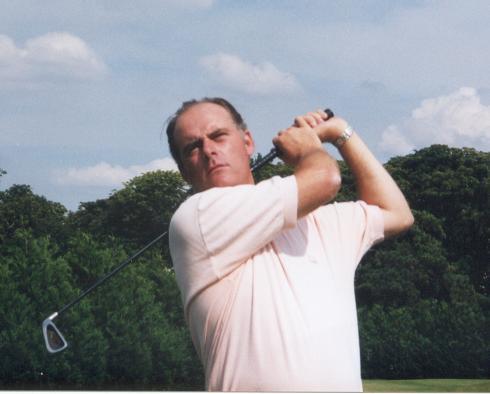
PIN HIGH CLINICS IN ETIOLLES JULY 18th TO JULY
22nd
AIM OF THE CLINIC :
- Improving your technical acknowledges or learn what to do in the future.
The aim is not to change all you learnt before (advanced), but to show you the
way towards a better swing.
- Personal adaptation to these technical drills because the bodies are not the
same
- Set up of a more confident swing, to show you that you're able (beginners) to
go on the course very quickly and avoid future physical
problems
Anyway, there won't be any difference between "beginners
language" and "advanced language". We will not learn "WHAT
TO DO" but "WHY TO DO IT".
DAY 1 : Monday July 18th
MORNING :
AROUND THE GREEN :
- Working on chipping with 9 iron.
The aim is to feel
that the way to hit the ball is the same whatever be the club. The angle of
the club face makes the ball fly. The swing must be the same as with a putter.
That means the width of the swing is the same on the right-hand side of the
ball and on the left-hand side of it.
Distance :
Distance is given more by the width of the swing than by the speed. To send
the ball further, you just widen the swing without changing the speed of your
shot. The more important is to find the right speed, that means the one you
control the best. We can say that the low part of the swing gives the directio
and the high part gives the distance.
Direction :
Direction of the ball is controlled by the hands. Try to find if you do it
better with the palm of the right hand or with the back of the left one.
- In the rough
The most important to consider is what we
call "the 3 points". When you hit a ball, three "moments" happen.
You touch the ball, you touch the ground and you have the lowest part of the
circle. Those three moments happen at the same time just on the carpet on the
driving range. That means that to make the ball fly from the rough, you must
consider how deep in the grass the lowest part of the circle will be.
That will help you to find and aim the point of entrance in the ground (on the
right-hand side of the ball) .
You can help the lowest part of the circle
to be lower by spreading the stance in the deep grass. You will increase the
speed of the club, and so the distance made by the ball, by using your knees
for a weight transfer while hitting.
The order of the things is "fingers - arms -
shoulders". So if you want the ball to roll, the backswing will be short
and the follow through willbe helped by turning the shoulders during the
impact. For the ball to fly, the backswing will be wider and the fingers and
wrists ( instead of shoulders) will help to make the ball fly higher.
The shot looks like the previous one in the deep grass. To play better in
the bunker, you have to feel that there is no difference between deep grass
and sand. We just make a difference between balls with the ground
"under" and balls with the ground "around".
Swing :
* The backswing is wide to have enough power to go through the sand and make
the ball fly
* The club must enter the sand behind the ball
* You have to finish the swing to help the ball to fly
The fact is that you have to consider that if you send the amount of sand
surrounding the ball on the green, the ball will get out of the bunker with
this amount of sand. Don't forget to control the back of your left hand, to
leave the club face open, so that the ball flies higher.
LONG SHOTS ON THE DRIVING-RANGE :
PRESENTATION OF THE METHOD :
To hit a golf ball properly, you need to respect a few fundamental rules :
- The hitting posture is
the same as the starting
posture
- The swing is as symetrical as possible (The
finishing posture is a consequence of the speed, not an obligation)
- The path of the club is the same during the backswing
and the downswing
What is going to be important is the fact that you have to find the points you
have to pass by, instead of the physical way you have to move .
Backswing :The hands are beside the head in front of the neck,
and the shaft of the club is in the same position as it was on the aiming
posture. The backswing helps for the direction of the flight of the ball.
Downswing : The hands begin the downswing to send the club and
the body back to the aiming posture.
Hitting area : The feeling to find is an association between the
right hand and the right knee. That is going to help the upper body to be more
steady. The speed given to the club face by your hands will make the ball fly
far. The importance of the follow through will help too.
Grip : We said that the grip is not very iportant in the flight
of the ball. Nevertheless, the club must be held in the fingers instead of the
palms, to gain power and relaxation. The fingers make the club move around
you.
AFTERNOON :
ON THE COURSE :
What I want to make you understand that you don't need to hit wonderfull
shots to score the way you want. You especially need to avoid to miss two
balls in a row, for example.
To do so, you must be more "strategic" than
"technical". That means that you should start with a 7 iron or a 5
iron, but not absolutely with a wood.
Advice of the day :
* Do some practice swings before playing
* Test the grass (don't do practice shots without hitting the ground)
* Beware your aiming posture
* Put the ball higher on the tee to swing easier
* Swing shorter whenyou are close to the green. Just try to send the ball on
the green.
* Don't think about the distance to reach, think about the impact area.
DAY 2 : Tuesday July 19th
PUTTING :
For the moment, the aim is to take an average of two putts
per green. To be able to do so, you must respect a few elementary rules :
* Eyes upon the ball
* Legs stiff and steady
* No wrists use
* Slow swing (distance is given by the width of the swing)
Aiming is easier if you align the name of the ball towards the target (the
hole or the slope)
Our advice of the
day is about the way to change the distance made by the ball.
Two ways :
* According to the stance. That means you swing between or wider than your
feet to make more or less distance
* Changing the stance so that you spread more or less to swing more or less
wide.
The advice of the day was about the way to find the right "br(e)ak(e)
point". You first have to look around the hole to know where the ball
will come from to enter the hole. To pass by this point, you have to reach
another point, more into the slope. That last point is the "br(e)ak(e)
point".
Put a coin down on the green to
aim this point and forget the hole. Anyway, the target is almost never the
hole itself. Most of the greens are too much sloppy for that.
AROUND THE GREEN :
Chipping
with 9 iron or 7 iron on the sloppy green:
- The swing must look like a clock. We saw that you can
imagine three widths for the swing :
* 7 to 5
*
8 to 4
* 9 to 3
Posture :
There is a difference between the posture of the long shots and the one on the
short game. As you stand far from the ball on long shots and very close on
putting, you have to adapt your posture (especially the distance from the
ball) to the short game.
* Hold the club shorter
* Get closer to the ball
* take a smaller stance
The width of the swing depends on the speed you hit the ball. If the swing
is slow, it is better to swing 9 to 3. If the swing is faster, 7 to 5 will
be enough.
- The choice of the club depends on the trajectory you
want to give to the ball. If you prefer to make the ball roll, 7 is better.
If you prefer it to fly, 9 or even SW will be allright (PW too). Another way
to change the flight of the ball with the same club is the position of the
ball . If you want the ball to fly , put it facing your left foot so that
your hands are behind it (the ball). This will help the wrists to move
hitting the ball. If the ball faces the right foot, your hands will be
"before" the ball, stiffening your wrists, and preventing the ball
to fly high.
- Remember to deal with the slopes, as you do with
putting.
LONG SHOTS ON THE DRIVING RANGE :
"ORDER OF THE THINGS" :
THE BACKSWING : We are going to build the
backswing according to the impact zone, and the way we want the club to hit
the ball. That means through the ball instead of downwards. The set up is
the following way : PUTTER STARTING / SET UP OF THE CLUB PATH / RAISE OF
THE HANDS.
Putter starting : We star the backswing the way
we start the the putter shot, that means without wrists, not to load too
fast. the fact to load the wrist makes the strike too much vertical (so
you're going to hit the ground). That is better for short clubs.
Set up of the club path : After that putter
start, we load the wrist to put the club parallel to the ground and towards
the target. The club is so on the same line as the line followed by the
hands during the "take away".
Raise of the hands : At this moment, you just
have to raise the hands according to the shot you wish to involve the
shoulders rotation.
Concerning the top of the backswing, I can give you a last advice.
The "important things" at that
point of the swing are : left arm parrallel to the ground and the shaft
making an angle of 90° with the left forearm.
AFTER THE BALL :
We'll find on the other side the same path as during the
backswing. You're so going to hit the ball the "putter way", the
wrist being unloaded during the downswing instead of during the strike
because of the lack of power. The club will come back parrallel to the
ground (as you did in the backswing), and you're then going to raise the
hands to the "technical finish" (the right knee follows). The
"Physical Finish" will follow, according to the speed of the
swing. You don't have to do the physical finish. It is the
technical finish (perfect symetry between the backswing and the follow
through) which is important and on purpose. It will be so possible to
increase the speed of the strike without increasing the width of the
swing.
The "important things" at
that point of the swing are : right arm parrallel to the ground and the
shaft making an angle of 90° with the right forearm.
EXERCISES : Do the backswing so that
the club points in from of you at the top, instead of towards the target.
As you try to bring it back to the ball, you feel that you need to use
your hips and legs to help the swing. This is the feeling you should
always have.
When you hit the ball, think "RIGHT
HAND / RIGHT KNEE / RIGHT SHOULDER"
AFTERNOON ON THE COURSE :
We saw that today was much better than yesterday because you began to trust
yourself. Your swing is improving because of the details we've been working on
since yesterday.
Anyway, the most important is to keep on trying to feel that every shot is the
same. You hit every ball the same way. Just the width and the speed of the
swing change. You even tried the 4 iron, which is not a very easy club to use,
because of its closed angle.
DAY 3 : Wednesday July 20th
WARM
UP :
What is
important in the warm up is to prepare your swing. That means you have to
prepare some particular parts of your body to do the swing.
- Shoulders (to help your arms to swing easier)
- Neck (for the steadiness of the upper body)
- Spine
- Legs
ON THE DRIVING RANGE :
THE SIX PARTS OF THE SWING :
Set Up : *
Bent forward
* Arms hanging
* Knees a little bent and weight on the toes
Take Away : * Club
parrallel to the ground and the flight line
* Wrists almost loaded
Backswing : * Hands up
* Shoulders following
* Weight on the right foot
* 90° between club shaft and left arm
Hitting : *
Club goes back to the ball
* Body goes back to aiming position
* Weight is back in the middle of the stance
Follow Through : * Club parrallel to the
ground in the direction of the target
* Weight on the left leg
* Right knee beside the left one
* Right foot up on his toe
* Arms straight
Finish : *
Club falls on the shoulders
* Body turns toward the target
Remember that the distance from the ball is given by 3
ways :
- Distance of your feet to the ball
- Distance of your head to the ground (you can be more or less bent)
- Distance of your knees to the ball. We saw that the fact to move your
knees too much during the backswing changes your distance and so your
posture. It will be so very difficult to find the ball on the downswing.
So try not to move too much the right knee at the beginning, and turn
around the left knee as you hit the ball and finish the swing.
About the speed, remeber that the wrists (or fingers) make the ball fly,
the arms (bending and straightening) make the ball fly further, and the
shoulders help to fly much further.
Think about unloading (in the downswing) where
you loaded (on the backswing).
Exercise :
- Take the position as if you
want to hit the ball
- Once you have found the right
posture and distance, put your feet together (left one towards the right
one), club in front of you
- Swing the club back as a full
swing
- At the top of the swing, put
your left foot back at its previous place (aiming posture)
- Hit the ball
After a few hesitating shots, you're going to feel what
is the weight transfer.
DAY 4 : Thursday July 21st
FOR ADVANCED PLAYERS :
How to change the height of the ball with the same club ?
Use of the shot : You are behind a tree, and you must make the
ball fly under the branches to reach the green. You would like to take
the 7 iron to make the ball roll but the problem will be that the ball
will go too far if you do so. The solution is to take the PW, which is
supposed to make the ball fly high, and make it fly lower.
How to do that : The position of the ball must change. For a high
ball, the ball is facing the middle of the stance. For a low ball, the
ball must face the right foot. The consequence of this will be that your
hands will be "before" the ball. You just have to hit the ball
with your wrists stiff, to keep the angle of the club closed. Beware the
posture ! you have to first take the posture with the club in the middle
of the stance (ball on the right), and then put the club back behind the
ball to keep the club face towards the target. If you just move to the
left for the ball to face your right foot, the club face will be open
and the ball will fly to the right.
FOR BEGINNERS :
We worked on the little high chips. You need the SW to do so. The
ball lies in the middle of the stance, the weight of the body is a
little on the left foot, to help you to contact the ground easier. The
swing is made by the wrists on the backswing, but you have to control
that you don't unload during the hit, otherwise you will top the ball.
WOOD ON A TEE :- The main difference is in the distance from the ball. As the swing will
be wider and faster down, the strike will happen "higher" than
usual, that means a few centimeters over the ground. If the club lies just
behind the ball, you will hit the ball in the heel of the club. So you're
going to miss the ball. You have to set up with the club
"beside" the ball. Just lifting the hands up, you see that the
club face is perfectly against the ball. So you can find it easier during
the downswing.
- The rythm of the swing must be always the same. The fact to miss the
ball comes more from an uncontrol of the impact zone than from a wrong
swing. So don't try when you miss to analyse the way you moved your body.
Try to think about the way your hands were during the impact zone. Correct
by ajusting the height or the accuracy of the club path.
- The posture is your own. It depends on the size, the elasticity of the
body, the weight and many other things.
- The notion of "throwing" or "hitting" give the
height of the tee. The hitter will put the ball lower and less on the
left-hand side, and the thrower will putt the tee higher and more on the
left.
We saw that the weight transfer is necessary to give
power to the strike. You have to feel that the weight tranfer begins just at
the moment you begin to swing your hands down back to the ball. That is
going to help your body to turn while hitting.
AROUND THE GREEN :
Chipping
from a longer distance:
Posture :
There is a difference between the posture of the long shots and the
one on the short game. As you stand far from the ball on long shots
and very close on putting, you have to adapt your posture (especially
the distance from the ball) to the short game.
* Hold the club shorter
* Get closer to the ball
* take a smaller stance
The width of the swing depends on the speed you hit the ball. If the
swing is slow, it is better to swing 9 to 3. If the swing is faster, 7
to 5 will be enough.
- The choice of the club depends on the trajectory
you want to give to the ball. If you prefer to make the ball roll, 7 is
better. If you prefer it to fly, 9 or even SW will be allright (PW too).
You increase the distance made by the ball by increasing the follow
through (towards the target) more than the backswing.Try to work your
aiming with putting two clubs on the ground in the direction of where
you want to send the ball. You have to follow the line of the club
shafts. 7 iron is the best club to play, because you don't need to make
the ball fly. Beware the slopes because they change the angle of the
club.
Today is a relaxing day. We've been working a lot this
week and I think that you all improved your acknowledges and your swing.
Now you need to gain confidence in yourself by playing more and more.
To finish our clinic, the best way is to have an
individual report on what you're supposed to work in the future. So I hope
these pictures will help you to do so.
|
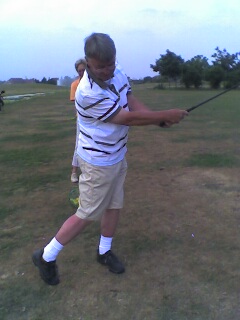

|
The main problem was a lack of
"bottom of the body". That means you usualy use your
shoulders more than your legs to give speed to the club. You can see
the difference between those two pictures : on the second one, the
legs are stuck on the ground and that makes your head
"dive" towards the ball, preventing your arms from
straightening. |


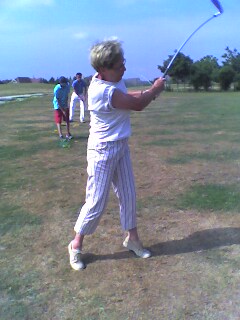 |
Just look at the difference between the
two first pictures. As the finishing posture is right (except the
legs maybe too much stiff), it would be easy to "accept"
the fact not to move your head to the right while swinging back. You
see the different positions of your head during the swing which
could explain some tooped balls. Your head is in fact moving too
much up and down. |
|

|
Just one picture, because you already
know what to work. To lower your handicap, you need more power to be
able to reach the greens in two shots as often as possible. The
power will come from the right use of your knees and hips. Work on
this position (knees and hips turned, arms straight through the
ball. |



|
Big improvement during the week. You can
see on those pictures that you're able to swing the club with more
control than strength. There's not a big difference between the
first and the third picture (your head could be more
"down"). But the position hitting the ball is perfect
(knees and hips turned towards the target, arms straight, head
down). Keep on working this way. |
|

|
You too just need one picture to see what
to work on in the future. Your legs are now most of the time moving
the right way. You just have to swing your arms towards the target
to perfect the control of the direction. Remember to conrol your
hands during the striking to prevent the ball from flying to the
right, as you did at the beginning of the week. |

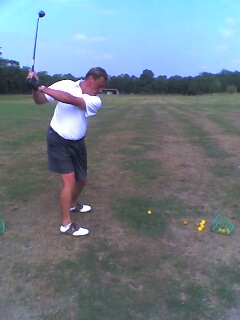

|
Big potential if you control your
backswing. As you can see on the two first pictures, you sometimes
swing too much "back". The club should be (as we said
during the lessons) over your neck, because your hands were hanging
under your neck while addressing the ball. On the first picture, you
see that the club shaft is aiming to the target at the top of the
backswing. Finishing position is good. |

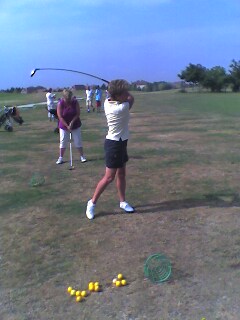
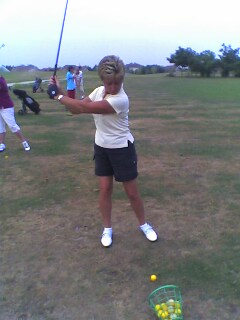
|
If you want to be able to hit the ball
the way you do it on the first picture, you have to control your
right knee during the backswing. The right hip should not move to
the right during the backswing because that prevents the knees from
moving during the strike. You can see it comparing the position of
your knees on the frist and second picture. |

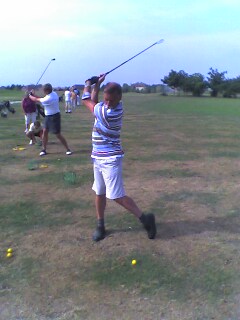
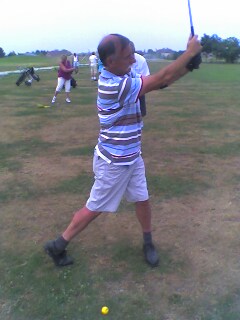
|
You can see that your finishing position
is the same as the backswing position I showed you on the first
picture. So the mistake (topping the ball, for instance) comes from
the second picture. You are too much "high", so your hips
turn too much and your head moves up. |



|
The only thing you have to work on is the
use of your legs during the hitting area. You can see on the middle
picture that it prevents you from straightening your arms as you do
it on the first picture. Anyway, I think you learnt and improved a
lot during this week. You have to improve at your own rhythm. |
I want to tell you that I enjoyed a lot to work with all of you (I repeat
that every week, but I really mean it) and I hope
to see you again in another PinHigh location
TOT ZIENST !
Home

















